To properly care for your nonstick pots and pans, it’s important to follow the manufacturer’s instructions. One of the key rules to keep in mind is to use non-metal utensils with non-stick cookware. The non-stick interior is not designed to withstand cutting food in the pan or using sharp-edged metal spoons and spatulas. Using metal tools to stir or remove food from the pan can easily damage the non-stick coating. Once the coating has scratches or holes, it is best to replace damaged cookware pieces.
When cooking with your non-stick cookware, consider using scratch-free cooking utensils made of wood, bamboo, silicone, or nylon. Kitchen utensils made from these materials will help you preserve the non-stick coating and extend the life of your scratch-sensitive cookware.

What to Look for When Buying Utensils for Your Non-stick Cookware
- Safety: Cooking utensils should be made from safe materials for food contact. Look for FDA-approved materials that won’t react chemically with acidic or hot foods.
- Anti-scratch function: To avoid damage to the scratch-sensitive inner coating, choose utensils made from scratch-friendly materials for non-stick pots and pans. Also, pay attention to an ergonomic design and a smooth surface.
- One-piece design: One-piece cooking utensils are less likely to fall apart. In addition, the food usually gets stuck in the area where the handle and body touch. One-piece utensils are more hygienic because there are no areas for bacteria to hide and multiply.
- Hanging holes: A hanging hole at the end of each utensil provides more storage options. Instead of storing them in the drawer, you can hang them on the utensil holder or the kitchen wall.
- Low maintenance: Your cooking utensils should be easy to use and clean. Dishwasher-safe or bacteria-resistant materials are more practical than those that require special care to stay clean and beautiful.
Before making your final decision, learn about the pros and cons of the cooking utensils commonly used when cooking with nonstick cookware.
4 Types of Utensils for Non-Stick Pans
1. Silicone Cooking Utensils
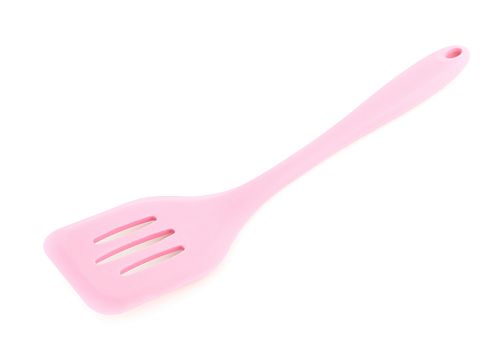
Make sure the silicone tools you choose are made from FDA-approved food-grade silicone. Be careful with cheap and imported silicone utensils, as silicone may contain potentially toxic fillers.
Pros
- High heat resistance: Most silicone utensils can withstand heat up to 450°F before melting. You can use them for frying and don’t worry if you leave a spoon unattended in the hot pan for a few moments.
- Durable: These kitchen tools are sturdy and long-lasting. They won’t warp, splinter, or corrode like other utensils. They always look like new and retain their bright colors even after many washes.
- Hygienic design: Silicone utensils are easy to keep clean. They do not absorb food residue and do not attract bacteria.
- Easy to maintain: Silicone kitchen utensils can be washed in the dishwasher or by hand. They are waterproof and dirt-repellent. Unlike wooden cooking utensils, they can easily be left in the sink overnight.
- Playful colors: They come in many pretty colors that maintain their vibrancy through use.
- Non-slip texture: The non-slip surface makes silicone cooking tools easy to handle and grip. The handles never get hot. Silicone items are also extremely light.
- The flexibility: The smooth silicone spatula is so flexible that you can easily flip a burger, scrape a mixing bowl, or scoop out the contents around the edges of glasses.
Cons
- Silicone kitchen tools are floppy and can bend when you use them. They won’t break, but the handles are not firm enough to mix food.
- Static electricity builds up on silicone items, causing them to attract dust, so utensils can look dirty if left unused for a long time. They also can retain a powdery residue after removing from the dishwasher.
Related product:
Silicone Utensils with Stainless Steel Inner Core
Some silicone tools feature a stainless steel core for added strength and stability. This steel core in the handles makes stirring thicker foods easier. Silicone is an excellent insulator, so the handles won’t get hot when stirring food on the stove. The handles will not break when you apply pressure to them or use them to mix a thick mixture. The spatulas offer sufficient resistance when mixing the heaviest dough while remaining flexible at the tip.
Recommended product: BESTZMWK Kitchen Utensil Set – 11 Cooking Utensils
Silicone Utensils with Nylon Core
There are also silicone kitchen utensils with a nylon inner core, which makes them sturdier than those made only from silicone. The all-in-one design gives them a solid feel and strength under pressure, but they are still soft and gentle enough not to scratch your non-stick pans.
2. Wooden Utensils

Pros
- Natural product: Wood is a natural product that does not release chemicals when cooking food.
- Decorative: Wooden cooking utensils look beautiful and elegant and easily match any kitchen decor. They give your kitchen a beautiful natural style.
- Comfortable to hold: Wooden utensils do not transfer heat and are comfortable and stable in the hand.
- Perfect for stirring and mixing: A wooden spoon is particularly suitable for stirring risotto, cooking caramels, and working with other foods that offer some resistance. It gets the job done faster and easier than a spoon made of flexible materials. A wooden spoon is also good for tasting the prepared food.
Cons
- High maintenance: Wooden utensils are not dishwasher safe and require occasional conditioning. Otherwise, they will soon show signs of wear such as dryness, cracks, and chips. To extend the life of these products, food-grade mineral oil should be applied regularly.
- Hygiene issues: Wood absorbs moisture and can absorb food particles, providing a good environment for bacteria to thrive. For this reason, wooden utensils are not considered hygienic.
- Not odor-resistant: Wooden utensils can stain and sometimes retain food odors. use a cleaning paste containing baking soda and water to eliminate food odors.
Related product: Gudamaye Wooden Kitchen Utensils Set
3. Bamboo Cooking Tools
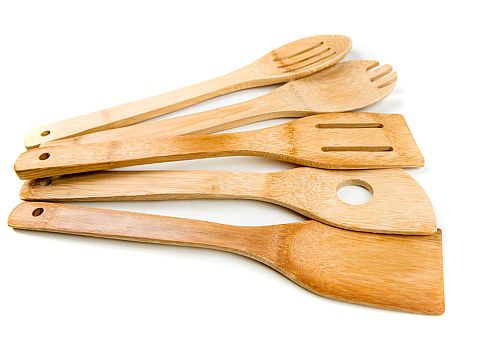
Pros
- Sturdy and durable: Bamboo kitchen utensils are long-lasting and strong. Bamboo tableware products are quite thick and do not warp or break due to wetness like wooden spoons.
- Stylish: These utensils add a natural touch to your kitchen. They are nice utensils for serving a salad.
- Comfortable to use: Bamboo utensils are lightweight and convenient to use. They are easy to grip and can be used for mixing or stirring.
- Anti-microbial properties: Bamboo has been proven to have a natural anti-microbial function, so you don’t have to worry about bacteria or germs accumulating in bamboo kitchen utensils.
- Environmentally friendly: Bamboo is a fast-growing plant and a highly renewable raw material. Bamboo utensils are biodegradable, recyclable, and environmentally friendly products.
Cons
- Not dishwasher safe: You need to wash them by hand with soapy water and avoid soaking them in water for a long time. Occasionally coating them with a food-safe oil will help maintain their shape and shine.
- Quality defects: Some imported items may have rough spots and edges due to inadequate quality control.
Related product: Luxxis Star Wars Gifts Kitchen Accessories Bamboo Cooking Utensils
4. Nylon Utensils
Pros
- Rigid and strong: They are strong enough to stir anything you cook or bake.
- Easy to clean: Nylon tools are dishwasher safe and therefore very easy to clean.
Cons
- Low heat resistance: Nylon is heat resistant up to 400 F. Nylon cooking tools are likely to melt if you leave them in the pan.
- Cheaper items may be bendy and prone to breakage.
- Nylon utensils cannot be considered environmentally friendly.
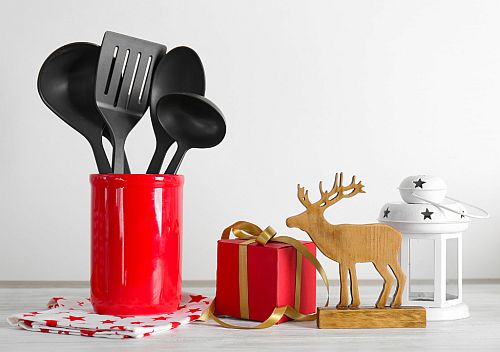


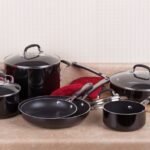
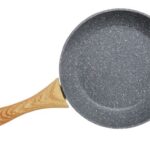
I am in the process of putting a new kitchen in my house and what are the best cooking utensils for non stick cookware. I’ve been inspired to stock up on all the staple cooking and baking utensil and other etc items. I am so excited to have a kitchen again and to get back into baking and cooking. I already had a lot of these, but this list helped me finish off my list of needed must haves. Thank you.
I’m a great fan of non-stick cookware. Thanks for posting an informative article, which really helps us to buy this type of product.
when cleaning your non-stick pot’s or pan’s you should use a scotch brite pad or equivalent, also it does’nt hurt to spray the pot or pan with a little cooking oil such as Pam it will make clean up a bit easier
Most non-stick cookware say NOT to use sprays like Pam and NEVER use an abrasive pad like scotch Britt….both will ruin your cookware!! Read https://www.today.com/food/7-ways-you-are-ruining-nonstick-pans-how-save-them-t104329